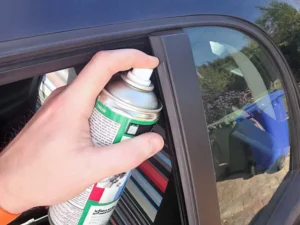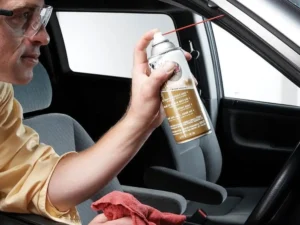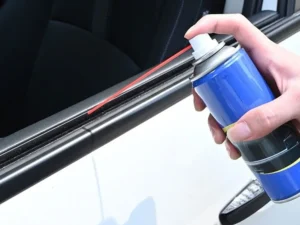Over time, your car window channel may get dry and accumulate dirt. What happens is your car window opens or closes slowly or even sticks. To solve this problem, you must adequately lubricate the auto window channel. The lubrication method is also similar for all sorts of vehicles.
This guide can help you whether you’re a part-time or full-time mechanic. Most importantly, it can be an excellent guide for those who work out of their garage on the weekend service in their own vehicle. This guide will show you some ways to service and repair your vehicle. So, let’s get started.
When do you need to lubricate your car window channels?

We always want a comfortable and hassle-free driving experience. Maintaining the smooth operation of your car’s window is crucial for this. Consecutively, one of the most important parts of this maintenance is lubricating the car window channel.
Now, the most common question is, when? When do you need to lubricate the car window channel before it worsens? Consider the following six situations to lubricate your automotive window channels.
Sticking or Jerky Movement of Window Glass
If your car windows stick, it’s clear that the seal that holds them in place needs to be oiled. You may also feel jerky movement during the operation.
Sticking windows may get caught on debris or uneven surfaces within the tracks, creating drag and making movement less smooth.
These two signs indicate that the window is encountering friction. To eliminate this problem, you must lubricate it.
Squeaking Sounds
You may often hear squeaking sounds when you roll the car windows up or down. It is one of the primary indicators that your car window tracks need lubrication.
Squeaking typically occurs due to friction between the window glass, rubber seals, or felt-lined channels. Over time, these components can dry out or accumulate dirt. Finally, there is more friction and noises that sound like squeaking.
Difficulty Rolling Up or Down
You may also notice that rolling your car windows up or down requires more effort. In such cases, you can be assured that your car window channel needs lubrication.
Difficulty in window operation also happens from dry or dirty channel surfaces. It creates increased friction and noise.
Visible wear or Damage to Car window channel seals
Check the rubber seals or felt-lined channels around your car windows. Do you see any signs of wear, cracking, or damage? If yes, then one of the causes is the negligence of lubricating the channels properly.
Damaged seals can create irregularities along the window channels, which increase friction. As a result, you may find sticking or jerky movement.
Lubricating the channels can help eliminate such damage to the seals. Consequently, it promotes smoother window operation.
Extreme weather conditions
In harsh weather, the car window track may need to be lubricated more often. This usually happens in the summer or winter.
Rubber seals tend to dry out and become stiff with high temperatures. When it’s cold, on the other hand, they may shrink and become less flexible.
Because of this, the channels need to be lubricated before bad weather starts. It can help you keep your windows working well all season long.
Regular Maintenance Intervals
During maintenance, you can also grease the channel for your car windows. Regular repairs can prevent problems before they happen.
You can follow the manufacturer’s advice on how often to do upkeep. It also lets you know when the window channels need to be oiled.
Which car window channel lubricant is the best for your project?

You can often choose between silicone and dry Teflon to grease your car window tracks. People love this option because it has so many great qualities.
Silicone stays slippery no matter what the weather is like. It ensures that the window works smoothly, regardless of weather or humidity.
In addition, silicone grease protects the window tracks for a long time. It also reduces friction and prevents premature wear and tear.
On the other hand, dry Teflon also works very well as a lubricant. It also keeps dirt and other things from building up. It makes the car window tracks last longer.
Both silicone and dry Teflon are good choices in general. They reliably and long-lastingly keep your car’s ducts oiled.
How to lubricate Car Window Channel

You already know that a smooth-running car makes driving more enjoyable. Keeping the window tracks in good shape is essential no matter what car you have.
Here are instructions for adequately greasing the channels in your car windows.
Lubricating your window system at the right time stops problems and makes it last longer.
So, do these steps to ensure your car window works well for a long time.
Step #1 Safety Precautions
You should always wear safety glasses and gloves to protect your eyes and hands. Getting splashed or touching grease could be risky. Work in a place with good airflow as well. Most of the time, it keeps you from breathing in grease fumes. You should know that most of these sprays are aerosols.
Also, make sure you park your car in a flat area. It prevents unexpected movements during the lubrication process.
If you don’t follow these safety measures, you might have problems. Some of these are the chance of getting hurt, breathing in toxic fumes, damaging the car, or not lubricating it enough.
Step #2 Preparation & Planning
As always, prepare all the tools and materials before you start the process. In this case, you’ll need an appropriate lubricant and a cleaning cloth. You must ensure that the chosen lubricant suits your installed car window channel.
Also, take a moment to learn how the car window system is put together. Finding the channel is the first step in improving the greasing process.
Step #3 Spray Car Window Channel lubricant in the Car Window Tracks
You can either use silicone lubricant or dry Teflon lubricant. Let’s take enough silicone down the car window edges that it could run out the bottom. And we’ll wipe it up with the rag. So, let’s go ahead and spray that.
Now, we can roll our window about a third up. You will already see that the windows are rolling a lot smoother. Let’s roll it back down. We’re going to do this a couple of times. So that spray has adequate time to drip down the bottom.
Do the same process for Halfway up and back down. And finally, repeat the process by going to the top this time.
By performing repeated lubrication, you will see that your window is moving up and down smoothly and is not sticking.
Step #4 Test the Windows
After lubricant is put in the car window channels, it’s crucial to ensure the windows roll smoothly. Carefully testing the windows can provide long-term benefits and help you take the steps you need to improve.
Carefully roll the window up and down several times to evaluate its movement.
Listen for any noise. If you find any squeaking noise, it needs further lubrication.
If you see any problems while testing, put a little lubricant on the places that are giving you trouble. Repeat the first two tests until the window works properly. Proper lubrication is necessary for best performance. It also keeps the window system from wearing out too quickly.
Frequently Asked Questions
Can you use WD-40 on car window tracks?
Yes, WD-40 can be used to lubricate car window tracks. But note that it is a water-displacing spray. Therefore, it dries faster and is not a long-term lubricant. Thus, silicon or Teflon-based lubricants will work best and last the longest. They are specifically designed for automotive applications. You can also use Vaseline for temporary lubrication.
Can you use Vaseline to lubricate windows?
Yes, Vaseline can be used as a temporary solution to lubricate car window channels. However, note that it may attract dust or dirt over time. In addition, it may hinder window operation. For long-term lubrication, a specialized car window channel lubricant is recommended. It provides perfect performance and durability.
Is silicone spray slippery?
Yes, silicone spray is slippery. It contains silicone oil, which makes the surface slick when applied. Its slipperiness makes it suitable for lubricating and reducing friction on many surfaces. Because of this, it is a good choice for lubricating car window channels and other parts of cars.
How long will silicone spray last?
Most silicone sprays last between a few months and a few years. If everything goes well, they can last up to 20 years. How well they work depends on the environment and how often they are used.
Summary
In summary, lubricating the car window channel is very easy. All you need is knowledge of how car windows work and what a car window channel is. The process is simple: start lubricating from the bottom part of the channel.
Then, keep the window a third of the way up and lubricate again. Do the same process halfway up and back down. Finally, repeat the process by going to the top this time.
If you need additional information, contact our customer support team. We have a team of professionals who are always happy to assist you.
